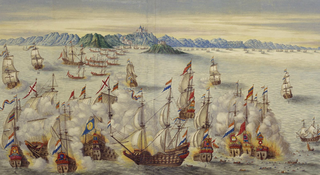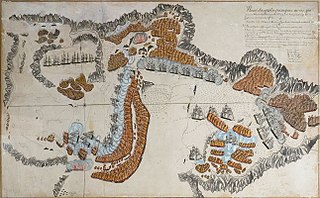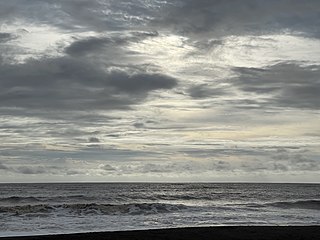
The Ottoman–Portuguese Conflicts (1586–1589) were armed military engagements which took place between the Portuguese Empire and the Ottoman Empire along the coast of eastern Africa.

The French frigate Minerve was originally launched in 1788 for the Portuguese Navy, where she served under the dual names of Nossa Senhora da Vitória and Minerva. The French Navy captured and renamed her in November 1809, after which she played a notable role in the Indian Ocean campaign of 1809-1811, participating in the defeat of a Royal Navy frigate squadron at the Battle of Grand Port, but at the surrender of Mauritius in December 1810, the ship was handed over to the British, and seems to have been broken up soon afterwards.

The Battle of the Gulf of Oman was a naval battle between a large Portuguese armada under Dom Fernando de Meneses and the Ottoman Indian fleet under Seydi Ali Reis. The campaign was a catastrophic failure for the Ottomans who lost all of their ships.
The Battle of Calicut took place between the Portuguese ship of the line Nossa Senhora da Misericórdia, commanded by João de Melo Saraiva and 21 Maratha ships that attempted to conquer the city of Calicut. The Portuguese were victorious and managed to make the Marathas retreat.

The Battle of Goa refers to a series of naval engagements between the Portuguese Armada and the Dutch East India Company fleets attempting to blockade and conquer the city of Goa. In 1638, forces commanded by the Viceroy of Portuguese India, D. Pedro da Silva and later António Teles de Meneses, fought off a large Dutch fleet sent to block the port colony of Goa, commanded by Admiral Adam Westerwolt, who was badly defeated at this encounter. The next year 1639, the Dutch Admiral Cornelis Simonsz van der Veere would conduct a new raid on Goa's port.

The siege of Mombasa was an attack on the Portuguese city of Mombasa and Fort Jesus by the army of the Ya'rubid ruler of Oman, Saif I bin Sultan, from 13 March 1696 to 13 December 1698.

D. Luís Carlos Inácio Xavier de Meneses, 1st Marquis of Louriçal and 5th Count of Ericeira was a Portuguese nobleman and colonial administrator, that served as Viceroy of India twice. His two tenures as Viceroy were notable for his continued military successes and for his economic rehabilitation policies. His first tenure, between 1717 and 1721, started when he was only 27 years old. His second tenure, between 1740 and 1742 started when he was 51 years old, and arrived in Goa, with six ships and 2,300 soldiers. Power and expansive policies led him to be dubbed the "greatest of the governors of the Orient of the first half of the 18th century."

The Battle of the Tiger's Mouth was a series of engagements between a Portuguese flotilla stationed in Macau, and the Red Flag Fleet of the Chinese pirate Ching Shih, led by her second-in-command, Cheung Po Tsai - known to the Portuguese as Cam Pau Sai or Quan Apon Chay. Between September 1809 and January 1810, the Red Flag Fleet suffered several defeats at the hands of the Portuguese fleet led by José Pinto Alcoforado e Sousa, within the Humen Strait - known to the Portuguese as the Boca do Tigre - until finally surrendering formally in February 1810. After her fleet surrendered, Ching Shih surrendered herself to the Qing government in exchange for a general pardon, putting an end to her career of piracy.

The Battle of El Tor was a military engagement that took place in 1541, between Portuguese forces under the command of the Governor of India Dom Estevão da Gama and those of the Ottoman Empire then in the city of El Tor, on the Sinai Peninsula. The Turks were driven from the city, but at the request of Christian monks from the Monastery of Saint Catherine the Portuguese spared the city from being plundered, and celebrated a mass and a knighting ceremony therein.

The siege of Colonia del Sacramento took place between October 1735 and September 1737, during the Spanish–Portuguese War (1735–1737).

Nossa Senhora da Graça, commonly known as Fénix, was a 46-gun frigate of the Portuguese Navy, launched in Salvador on 13 August 1787. The frigate was seized by the French in 1807 during the Invasion of Portugal during the Napoleonic Wars. In 1808, the frigate was recaptured and returned to Portuguese service. In 1819, the frigate was no longer deemed serviceable and was burned.
Charrua is a Portuguese nautical expression of the Age of Sail, initially used to designate the use of a frigate or a ship of the line owned by the State as a transport ship, reducing armament and complement, like the French nautical expression en flûte.

The Portuguese conquest of Daman was a military campaign undertaken by the Portuguese Empire against the city of Daman, in India, until then owned by the Sultanate of Gujarat. The Portuguese captured the city.

The Battle of Daman took place on 23 March 1694, when a Portuguese squadron, commanded by General António Machado de Brito, pursued and attacked an Omani squadron sailing off Daman.
The Battle of Mamora (1696) took place in the summer of 1696 between the Portuguese and Moroccan fleets off the coast of Mamora. The Portuguese left the battle victorious after repelling several Muslim vessels.
The action of 29 November 1726 was a minor naval battle fought between a Portuguese ship of the line defending three merchant ships from two Algerian pirate ships off the Portuguese coast.
The action of 27 May 1802 was a single-ship action which took place in the Mediterranean Sea, when a 36-gun Portuguese frigate, commanded by the French capitão de mar e guerra João Luís de Seguin Deshon, was captured by a 44-gun Algerian frigate, commanded by the privateer Raïs Hamidou.
The action of 26 May 1789 was a minor naval engagement fought off Algiers, Mediterranean Sea, in which a small Portuguese division, commanded by coronel do mar José de Melo Breyner, spotted an Algerian xebec accompanied by a captured French ship, the Le Désir, of which he was forced to abandon and flee, pursued by the Portuguese brigantine Lebre.
The Cabinda Expedition was a military action carried out by Portugal, departing from Brazil, against British positions established in Cabinda, Angola. It was the only recorded conflict between the Portuguese and the British during the reign of King John V of Portugal.














